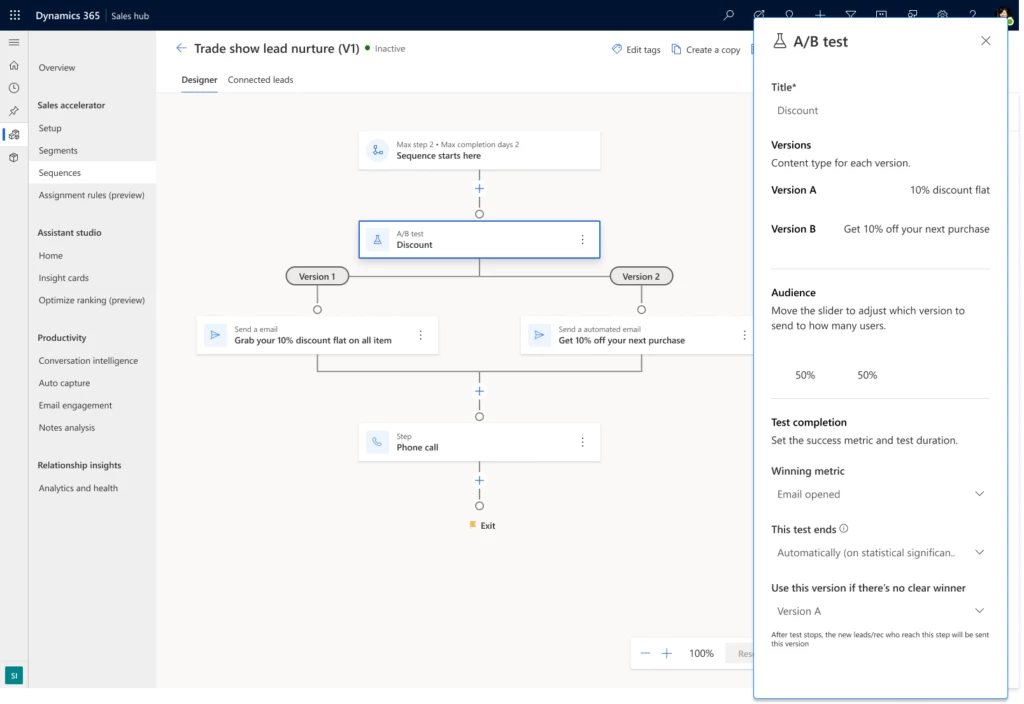
Winning sales sequences: A/B testing guide
In the Sales world, business success is often dependent upon effective communication with customers. One of the most common ways to reach out to customers is through email, making it essential to have effective email content. However, determining the best content for an email can be a challenge, especially when there are many variables at play.
This is where Dynamics 365 Sales sequences with A/B testing can now help!
Sequences help sales managers enforce best practices, ensuring that all sellers follow the same series of steps for successful customer engagement. Email is an essential part of these sequences, and A/B testing can help find the most effective versions of an email to drive customers to the desired action.
Through A/B testing in Dynamics 365 Sales sequences, sellers and sales managers can now test different versions of an email and automatically select the one that performs better.
Drive better business outcomes with A/B testing
A/B testing enables you to determine which variation on an email drives more customers to take the desired actions. With our new A/B testing capabilities in Dynamics 365 Sales sequences, you don’t need to be an expert statistician to design and run such experiments. The system runs the numbers for you, and automatically determines the version that brings better results with statistical significance. This takes the guesswork out of the sales process. It allows sales managers to make data-driven decisions that improve customer communications and drive better business outcomes.
Here are some of the key capabilities of A/B testing:
- Experiment with different versions of the subject line or entire email content.
With sequence testing, you can create multiple versions of an email with different subject lines or content to see which one performs better. For example, you can test two versions of an email, one with a question in the subject line and one without, to see which one drives more customers to open it. - Control distribution of email versions.
You can control the distribution of different email versions, so that a certain percentage of recipients receive one version and the rest receive the other. This ensures that the results are statistically significant and accurate. - Select the winning metric.
You can choose the metric that determines the winning email version, such as open rate or click rate. Open rate is the percentage of recipients who opened the email. Click rate is the percentage of recipients who clicked on a link within the email. - Automatically determine the better performing option with statistical significance.
Finally, the A/B testing tool will automatically determine the better performing option based on the selected metric and statistical significance. Statistical significance is a measure of the probability that the difference in performance between the two versions is not due to chance.

Make data-driven decisions with A/B testing analytics
Sales managers may use A/B testing in sequences to make data-driven choices, removing guesswork from the sales process. This strategy leads to improved customer communication, better business outcomes, and, ultimately, a higher possibility of success.
It’s important to note that there are different approaches to email A/B testing:
- Experiment with different subject lines to see which one drives more customers to open the email.
- Experiment with the entire content of the email to see which one drives more clicks or conversions.
Deciding which approach to use depends on the specific goals of the email campaign and the tracked metrics.
Once the better performing option is selected, it’s important to continue running a small experiment. This is to ensure that it continues to outperform the other options. This helps to prevent any unintended consequences that may arise from any changes made to it. Good news – we run such micro experiments in background automatically, so you don’t have to do anything.
Additionally, there are various analytics available for A/B testing in sequences, such as open rates, click rates, and conversion rates. We also show you what portion of the audience received each version. These analytics can provide valuable insights into the effectiveness of different email versions and help sales managers make informed decisions about their email campaigns.

Conclusion
In conclusion, A/B testing in sequences is a powerful tool that can help sales teams improve their customer communication, drive business success, and gain a competitive edge in the marketplace. By experimenting with different versions of an email, controlling distribution, selecting winning metrics, and continuing to run small experiments, you can make data-driven decisions that improve business outcomes. With the right approach and analytics, A/B testing in sequences can help you optimize your email campaigns for maximum impact.
Next steps
Don’t have Dynamics 365 Sales yet? Try it out now: Sales Overview – Dynamics Sales Solutions | Microsoft Dynamics 365
Learn how to Improve Sales process efficiency using sequence insights – Microsoft Dynamics 365 Blog
Learn more about sequences and how to create them:
Sequences in sales accelerator | Microsoft Learn
Learn more about A/B testing in sequences:
Utilize A B testing in sequences | Microsoft Learn
Explore our getting started templates to quickly create sequences and try them for yourself:
Sequence templates | Microsoft Learn



